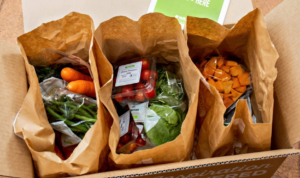Grab is a young and fast-growing tech company with strong market positions in Southeast Asia. The company was founded as a kind of Uber to match taxis and customers, but has grown into a super app that allows users to initiate all kinds of activities. Grab has been listed for two years and despite the phenomenal growth that the company has experienced, investors became scared by the persistent losses and drove the share price down by almost 80%. Management has gotten the message and is working its way to profitability. Losses have been decreasing significantly in recent quarters and last quarter the adjusted EBITDA was positive for the first time. However, the stock is still very low, so the risk-return trade-off is clearly positive .

Establishment
The company was founded in Malaysia by Anthony Tan, the son of a Chinese entrepreneurial family whose father had built up a large car company to assemble Nissan cars. After school, the young Anthony started working in his father’s company, but he could not find his place so he left for America to continue his studies. In 2011, he and his classmate Tan Hooi Ling participated in the HBS New Venture Competition at Harvard for the best business plan. Malaysian taxis consistently ended up at the bottom of the customer satisfaction lists of tourists about taxi services, which gave the duo the idea to submit a business plan for an app to connect taxi drivers and customers. They won the second prize of $25,000, which was intended to start their own company. Once back in Malaysia, they immediately got to work, so that the app was ready in 2012 and their company was named ‘MyTeksi’.
Growth
In 2013, the name changed to ‘GrabTaxi’ and the app was introduced in neighbouring countries such as Singapore, Thailand and the Philippines, later followed by Vietnam and Indonesia. Grabtaxi was very popular, which prompted Tan to expand the service to motorcycle riders (Grabbike) and regular car owners who want to play taxi driver (GrabCar). Later, GrabCar+ followed for special transport and large groups.
In December 2014, the company received a capital injection of $250 million from Japanese venture capitalist Softbank, which allowed it to make great strides. Tan realized that if the drivers were driving around anyway, they could also deliver packages. This is how GrabExpress was born. The app was given a functionality for paying for taxi rides, the so-called GrabPay. In 2018, Grab, as the company was then called, acquired Uber’s activities in Southeast Asia, which added new functionalities to the app. For example, GrabFood is a food delivery service and GrabAds offers advertising options. Other functionalities of the app are: Grabkitchen, GrabMart, GrabFinance, GrabInsurance, GrabInvest and Grabdefense.
Venture Capital
The above-mentioned financing from Softbank was part of the fourth investment round. Before that, only local investment companies from Malaysia and Singapore participated in the financing. Once Softbank came on board, big names such as Toyota, Microsoft, Honda, Didi, Temasek and Booking Holdings from Amsterdam followed. In total, Grab raised more than $10 billion from private parties before going public in December 2021. Almost a third of that amount came from Softbank.
IPO
In 2021, Grab had over 2 million drivers on the road, making 3.5 million trips a day, making the super app ready to list on the Nasdaq. In December 2021, Grab merged with US Spac Altimeter Growth, initially raising its market cap to over $40 billion and making it the largest IPO ever by a Spac. The stock opened up 30% higher, but closed its first day of trading at $8.75, $1.25 below its IPO price. Softbank remains the largest shareholder with a 16.7% stake, Uber has a 14.3% stake from the sale of its Southeast Asian operations, Didi, also known as China’s Uber, owns 7.2% and Toyota 5.9%. Founder Tan was briefly a billionaire on the first day of trading, but he now only owns 3% of the ordinary shares, although he still has 63% of the voting rights.
Current company
The operations are spread across more than 500 cities in eight countries. In total, more than 600 million people live there, of whom 5% use the Grab app at least once a month for one or more services. More than two million people earn money through Grab in one way or another.
The current company has organized its activities into four divisions:
- Mobility: all taxi-related services and passenger transport;
- Deliveries: meal delivery and express services;
- Financial Service: Grab has a banking license and provides insurance;
- Enterprise & New Initiatives.
Once customers download the app, they enter Grab’s ecosystem and will in most cases purchase more services later. In this sense, the business model is similar to other super apps such as China’s Tencent and India’s Tata Neu. Grab has excellent partnerships across all its services in various sectors, such as hotels, restaurants, financial institutions and governments. In fiscal 2022, the revenue was $1.4 billion and in 2023, the revenue is expected to exceed $2.2 billion.
Financial results
In the food delivery and passenger transportation markets, it is of paramount importance to become the undisputed market leader. New suppliers and new consumers will prefer an app that most people are already connected to. That is why companies like Just Eat Takeway and Uber show high revenue growth, but it takes so long to become profitable. They have to invest heavily in marketing and offer enticements to attract new customers, so that they can take the lead. Besides the fact that both spacs and tech companies fell out of favor with investors in 2022, the persistent losses are the main reason why the stock has performed so poorly.
Management has picked up the message well, which is clearly visible in the quarterly results. The attached chart shows that operating losses have been significantly reduced. More than 1,000 jobs have been cut and, more importantly, the expenditure on attracting new customers has been halved as a percentage of GMV.

Latest quarterly figures
The September quarter still resulted in a loss of $99 million, but that was much better than the $342 million a year earlier. Moreover, the cause was non-cash write-downs. The cash position rose above $3 billion again, which was more than a billion more than at the start of 2023. An important milestone was that the adjusted EBITDA was positive for the first time at $29 million. A year earlier, that adjusted EBITDA was still $169 million negative. At the Deliveries division, the adjusted EBITDA rose from $9 billion to no less than $88 billion, while turnover was ‘only’ 80% higher and the GMV only 7%. The Mobility division grew less spectacularly, but still made by far the largest contribution to turnover with $231 million. The adjusted EBITDA rose from $135 million to $180 million. At Financial Services, revenue more than doubled to $50 million, while adjusted EBITDA improved from negative $105 million to negative $68 million. At the Enterprises & New Initiatives division, adjusted EBITDA increased from $8 million to $21 million.
Assessment and conclusion
We assume that EBITDA will be positive next year, but it is difficult to estimate how high it will be. The ratio between the enterprise value and the turnover is 4.1x. That seems quite expensive in itself, but a comparable company like Doordash is also listed at that multiple and Uber is only slightly cheaper at 3.6x. Grab’s growth potential is much higher, which justifies a higher multiple. Analysts have had to revise their estimates for the earnings per share considerably upwards in the coming years (see graph). We suspect that if Grab’s cash flow is positive next year and profitability increases significantly, investor interest will also increase considerably. A price of $4, which was still on the boards in 2023, seems very feasible. Sharesunderonetenner is adding 500 shares of Grab to its portfolio at the current price of $2.92.
The author holds GRAB warrants
Grab Ticker Fundamentals
: Grab
Ticker Warrants: GRABW (Exp Dec’26 @$11.5)
ISIN Code: KYG4124C1096
Stock Listing: Nasdaq
52-week High: $4.03
52-week Low: $2.65
Last Price: $3
Shares Outstanding: 3,907 Million
Market Cap: $13.7 Billion
Enterprise Value: $9.09 Billion
EV/Sales: 4.12x Price to Book Value Equity: 2.07x



